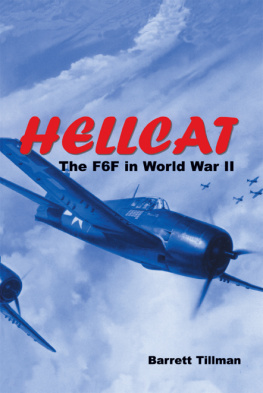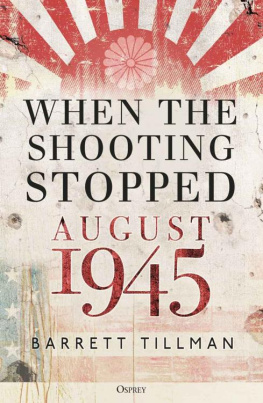


Copyright 2014 by Barrett Tillman
All rights reserved. No part of this publication may be reproduced or transmitted in any form or by any means electronic or mechanical, including photocopy, recording, or any information storage and retrieval system now known or to be invented, without permission in writing from the publisher, except by a reviewer who wishes to quote brief passages in connection with a review written for inclusion in a magazine, newspaper, website, or broadcast.
First ebook edition 2014
eISBN 978-1-62157-312-8
The Library of Congress has cataloged the hardcover edition as follows:
Published in the United States by Regnery Publishing
A Salem Communications Company
300 New Jersey Avenue NW
Washington, DC 20001
www.Regnery.com
Originally published in 2004 by Brasseys, Inc. in hardcover form. Paperback edition published in the United States in 2005 by Potomac Books, Inc.
22841 Quicksilver Drive
Dulles, VA 20166
10 9 8 7 6 5 4 3 2 1
Books are available in quantity for promotional or premium use. For information on discounts and terms, please visit our website: www.Regnery.com.
Distributed to the trade by
Perseus Distribution
250 West 57th Street
New York, NY 10107
CONTENTS
IMAGES
MAPS
C ompiling D-Day Encyclopedia has been an education. Having researched and written military history most of my life, I felt that I had a firm grasp of the subject before I began.
How naive I was.
While I was intimately familiar with the aviation aspects of D-Day and had a good grasp of the naval phase, it became obvious the more I learned the less I knew. The depth and complexity proved infinite; the variety seemingly endless. I came away with an even greater appreciation of the master works on the subject by Cornelius Ryan and Stephen Ambrose, among others.
Research sources are variedin official documents, professional and popular histories, and in cyberspace. The amount of D-Day material on the internet is astonishing, and much of it is reliable.
The scope of this study is necessarily limited: as a rule it deals specifically with D-Day itself. Only those Allied divisions directly engaged on 6 June are described. However, some later segments of the Normandy campaign are included for continuity, such as the Falaise gap and the capture of such vital cities as Saint Lo, Caen, and Cherbourg.
Rather than restrict the entries to purely military, naval, and aviation topics, however, I felt justified in addressing some cultural aspects. The events of 6 June 1944 immediately became a collective milepost on the path of the twentieth century, and I wanted to place them in more than a wartime context. Therefore, I have included some D-Day topics related to popular culture: music, motion pictures, museums, even D-Day quotations. It also seemed appropriate to include entries for notable D-Day historians, such as Stephen Ambrose, Forrest C. Pogue, and Cornelius Ryan.
The organization of this encyclopedia is somewhat different from most. Rather than scatter topics throughout the text in strictly alphabetic fashion, I have grouped certain subjects for easier reference. For instance, the aircraft that played significant D-Day roles are grouped under the Aircraft heading. They are subdivided by nationalityAmerican, British, and Germanand listed by manufacturers within the country of origin. It is far easier to compare the Avro Lancaster and the Junkers 88, say, within the same section rather than flipping from A to J. Aircraft popular names (Flying Fortress, Spitfire, etc.) also are cross-referenced. The same applies to tanks and weapons, each of which has a section. For example, the U.S. Armys M1 Garand rifle is detailed under Weapons, American, but references are included under Garand and M1 Rifle.
Sources of technical information for aircraft, vehicles, and ships are provided in the bibliography. In some instances the data are representative rather than specific, owing to the existence of multiple versions of particular tanks or airplanes in use during 1944.
Specific Allied operations are cross-referenced; Operation Overlord is also found under Overlord. Cross-referenced topics are rendered in bold-face letters the first time they appear within individual entries.
Some biographical entries have never appeared in D-Day literature before. I felt strongly that weapon designers such as John C. Garand and John M. Browning should be included, as between them they provided the U.S. Army with six of its ten primary firearms: the M1 rifle, the M1911 pistol, the Browning Automatic Rifle (BAR), and the M1917, M1919, and M2 machine guns. No comparable number of British or German weapons were so closely identified with individual designers.
The subjects of this volume are slanted toward an American audience. Several of the military and political figures behind the scenes are included; many are not. Most of the governmental leaders are naturally cited (Churchill, Roosevelt, Hitler), but recalling that six nations were represented in the Normandy campaign, I have also included Free French and Vichy figures as well as Canadians and Poles. The Soviets, who launched a massive offensive two weeks after D-Day, also are cited.
Finally, the bibliography at the end of the volume is a reference in itself. Some of the titles will be familiar to D-Day students, while others are out of print or remain obscure. But all proved valuable in helping to compile a single-volume reference devoted to the greatest military operation of all time.
Thanks to John L. Tillman, Mark Bradley and Bob Burbage in Britain, Derrick Martin, D-Day historian Martin K.A. Morgan, and Seth Paridon of the National Museum of World War II.
Barrett Tillman
April 2014
A-20.
See .
ACRONYMS.
The vocabulary of D-Day and World War II is hung on the framework of acronyms. The subject includes the evolution from SHAEF (Supreme Headquarters, Allied Expeditionary Force) to COSSAC (Chief of Staff, Supreme Allied Command), which oversaw the ETO (European Theater of Operations). Among weapons, the BAR was the ubiquitous Browning Automatic Rifle; PIAT was the British Projector, Infantry, Anti Tank weapon. Pluto was the pipeline under the ocean, supplying petroleum to Allied forces in France.
Naval acronyms included LST (Landing Ship, Tank) and LCVP (Landing Craft, Vehicle, and Personnel), better known as the Higgins Boat.
In addition to hundreds of official acronyms there were many informal but even more popular versions: RHIP (rank has its privileges) and SNAFU (situation normal, all fouled up).
AIRBORNE OPERATIONS.
In the fifteenth century Leonardo Da Vinci envisioned airborne soldiers, and in the nineteenth century Napoleon Bonaparte pondered invading Britain with French troops in hot-air balloons. But not until the 1940s did the technology exist to transport large numbers of specially trained soldiers behind enemy lines and deliver them by parachute, glider, or transport aircraft.
German airborne forces included paratroops and glider and transport-lifted infantry, all controlled by the Luftwaffe. Eventually nine parachute divisions were established, but few Fallschirmjaeger (literally parachute hunters) made combat jumps. Nonetheless, Germany led the way in combat airborne operations, seizing Belgiums Fort Eben Emael in 1940. The Luftwaffe also made history in the first aerial occupation of an islandthe costly Crete operation in 1941. However, Germanys Pyrrhic victory proved so costly that no
Next page







![James Francis LePree Ph.D. (editor) - The Byzantine Empire [2 volumes]: A Historical Encyclopedia](/uploads/posts/book/296844/thumbs/james-francis-lepree-ph-d-editor-the-byzantine.jpg)






